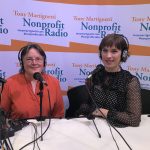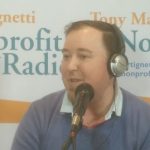
Matthew Zachary: Don’t Work For Free

Your brand, programs, assets and communities are a commodity worth assigning value to. Is it time to tell a company, or other potential partner, “Thanks, but no thanks.” Matthew Zachary from OffScrip Health shares his advice.
Listen to the podcast
Podcast: Play in new window | Download
Get Nonprofit Radio insider alerts!
I love our sponsor!
![]() Turn Two Communications: PR and content for nonprofits. Your story is our mission.
Turn Two Communications: PR and content for nonprofits. Your story is our mission.
We’re the #1 Podcast for Nonprofits, With 13,000+ Weekly Listeners
Board relations. Fundraising. Volunteer management. Prospect research. Legal compliance. Accounting. Finance. Investments. Donor relations. Public relations. Marketing. Technology. Social media.
Every nonprofit struggles with these issues. Big nonprofits hire experts. The other 95% listen to Tony Martignetti Nonprofit Radio. Trusted experts and leading thinkers join me each week to tackle the tough issues. If you have big dreams but a small budget, you have a home at Tony Martignetti Nonprofit Radio.
View Full Transcript
Processed on: 2022-03-25T11:34:28.580Z
S3 bucket containing transcription results: transcript.results
Link to bucket: s3.console.aws.amazon.com/s3/buckets/transcript.results
Path to JSON: 2022…03…584_tony_martignetti_nonprofit_radio_20220328.mp3.262299679.json
Path to text: transcripts/2022/03/584_tony_martignetti_nonprofit_radio_20220328.txt
[00:00:25.64] spk_0:
mm hmm. Hello and welcome to tony-martignetti non profit radio Big nonprofit ideas for the other 95%. I’m your aptly named host of your favorite abdominal podcast. Oh, I’m glad you’re with me. I’d suffer with parallel
GMA. If [00:01:49.74] spk_0:
you broke me with the idea that you missed this week’s show, don’t work for free. Your brand programs, assets and communities are a commodity worth assigning value to. Is it time to tell a company or other potential partner? Thanks but no thanks. Matthew Zachary from off script health shares his advice. non tony steak too. Please take care of yourself. We’re sponsored by turn to communications pr and content for nonprofits. Your story is their mission turn hyphen two dot c o. It’s a pleasure to welcome Matthew Zachary to the show. He is a 26 year brain cancer survivor and one of the most respected voices in healthcare. He’s an award winning concert pianist and film composer And the host of out of patience with Matthew Zachary, the # one podcast in healthcare. He founded the award winning nonprofit stupid cancer. Matthew is now Ceo and co founder of off script Health, the first audio broadcasting company focused solely on consumer health and patient engagement. He’s at Matthew Zachary dot com and at Matthew. Zachary. Matthew. Welcome to nonprofit radio [00:01:51.64] spk_1:
Hello tony [00:01:53.84] spk_0:
pleasure to have you. [00:01:55.01] spk_1:
Likewise, thank you for having me on the show. [00:01:57.17] spk_0:
I’m glad you’re on from from new york city [00:02:00.14] spk_1:
from the heart of Manhattan [00:02:02.54] spk_0:
downtown where where where are you downtown? In Manhattan [00:02:05.62] spk_1:
we are between the world trade center and the South street seaport [00:02:09.94] spk_0:
Well, you’re very far down. Okay. I mean, I consider Chelsea downtown, your, your financial district [00:02:18.04] spk_1:
downtown, just like near the, near the bay Battery. [00:02:24.94] spk_0:
The battery near the battery. Right? Yes. All right. Welcome. Glad to have you. We’re thrilled [00:02:25.83] spk_1:
to rant and rave to your listeners. [00:02:28.54] spk_0:
You ready to rant and rave. Please do. And [00:02:31.30] spk_1:
I’m [00:02:31.93] spk_0:
already correcting you. They’re our listeners, please. Our listeners [00:02:36.41] spk_1:
listeners, [00:03:12.34] spk_0:
listeners. No, no, don’t, don’t disqualify it. There are listeners rant and rave. Please tell stories. And we’re gonna be talking about some stories, uh, some of your stories and your background, but we’re getting started. You know, we want to get started. We’re talking about non profits, undervaluing their assets. And uh, let’s set up your, your bona fides to talk about this. What, what is it in your background that leads you to the, to the, uh, to the belief that this is a problem that nonprofits are, are, are causing for themselves. This undervaluing, [00:04:38.94] spk_1:
I have the terrible privilege of having started the nonprofit with no experience in 2006 and then running it too To success by accident over 14 years. And it’s often the most unqualified human that doesn’t write the wrong way. And I spent a decade working at Omnicom in the agency space after surviving brain cancer in college. So I learned a lot And this is pre internet, pre google pre everything. This is a ol floppy disks and dial up and crappy Macintoshes and gateway computers. That’s the era in which I kind of grew up with. And back then consumers really valued, you know, good brands and direct to consumer wasn’t really a thing yet. There was no like banner ads pervaded but health care and cancer and rare disease wasn’t really a market. We were kinda left to our own devices and I wound up meeting a guy who happened to be on the board of directors of a group called the National Coalition for Cancer survivorship. They are five oh one C three and the five oh one C four group in the beltway, probably the single most influential group no one’s ever needing to have heard of because they get all the things done behind the scenes in cancer policy access CMS, payer equity F. D. A. There there, wizard. [00:04:46.40] spk_0:
Well we have, we have jargon jail on tony-martignetti non profit radio [00:04:52.13] spk_1:
jargon. But where can I do that? [00:04:53.83] spk_0:
There’s no button. I just, I just interrupt you brashly like I just did [00:04:59.94] spk_1:
Medicare services, the federal Drug Food and Drug Administration and insurance companies. [00:05:04.24] spk_0:
What is CMS, [00:05:05.47] spk_1:
Comprehensive Medicare services. [00:05:07.35] spk_0:
Thank you. Okay. [00:05:08.42] spk_1:
Yeah. Okay. So yeah, I will, I will do the acronym for the rest of the day if you [00:05:14.05] spk_0:
please, but if you forget, I’ll remind you. Don’t worry. [00:05:46.84] spk_1:
But I wanted to start a nonprofit having no experience understanding what that was because I saw, I saw a marketing need, I saw a business opportunity and before I get to the second part of that thought nonprofits are still businesses and fundamentally, most people that start nonprofits, I have no data to support this are doing it because of emotional desire and not practical forward thinking. Well [00:05:47.34] spk_0:
that sounds like it was your own experience. You said [00:05:49.52] spk_1:
yes, you [00:05:50.79] spk_0:
blundered, you maybe didn’t blunder into it, but you blundered through it. I [00:07:38.14] spk_1:
blundered through it with no experience. But I always ran it like a for profit company. It happened to be a tax examples, you know, I. R. S. Status, but I never thought that I would want to ever beg people to give couch cushion money to keep the lights on. I’m not that kind of person and I genuinely believed and you could commoditize cancer patients because they’re just consumers and they want to feel like they’re part of a community and they want to give back in a way that they can get paid for having their life experience sold to somebody that didn’t ask to have that wisdom but also figure out ways to monetize the revenue portfolio of the company without being dependent on donor dollars. And that that was my approach. Then I even tell you was that, oh my God, no one’s ever done this. I’m gonna try it. And then I was met with like, oh you need a board of directors, you need to, you know insurance, you need to have the audience, I don’t know these things but fumbling through that with the onset mindset that this is a business first and foremost that happens to be a nonprofit was antithetical, but I think it’s an underserved narrative in why most nonprofits fail, Why most non profits earned less than $50,000 a year and why the government made it way too easy to get to C3 status because they just know that they just want to have this on the books were the good government, we get the C3 status and I’ll end that thought with one of my friends and heroes and mentors is dan Pallotta, dan Pallotta had the most watched ted talk in history, [00:07:44.25] spk_0:
an [00:08:05.24] spk_1:
old friend, the way we think about charity is all wrong. It talks about GDP issues and the fundamental flaws and scaling and growth and equity and value and you know, he taught me a lot, getting this off the ground and I was privileged to have him kind of be the jiminy cricket that validated my approach that this is a business that happens to be a charity? [00:09:41.64] spk_0:
It’s time for a break. Turn to communications. Your story is their mission. What does that mean? What do you want to tell? What story do you want to tell? What audience do you want to tell it to? What channel or channels do you want to use to tell that story. All of that is what turn to does that makes your story their mission. So, and they’ll help you refine that story. They’ll they’ll maybe help you find that story, not just refine it, but help you find it. And then they’ll help you figure out who the best audiences are. You probably have a good sense of that, but they can help who the, what the best channels are. They definitely can help you with that. And then hone that story and tell it, get it out. Whatever, whether you’re going to use earned media or owned media, whatever channels you’re going to use, they’ll get it out. All of that means that your story is their mission Turn to communications turn hyphen two dot c o. Now back to don’t work for free. What about the undervaluing part? What what, what did you were there lessons you learned and you said you didn’t you never wanted to pursue a couch cushion, pennies as donations. But where did your thinking about nonprofits not sufficiently valuing themselves come from? [00:09:49.34] spk_1:
Right. So this goes to how industry and the cockeyed fucking nous of healthcare. Is that the people that make the drugs that you and I take it? We’re not [00:09:56.42] spk_0:
customers appreciate your saying this. Yeah, [00:09:59.31] spk_1:
it’s factory. [00:10:01.34] spk_0:
Right? Wait, say that 1. 2. [00:10:03.86] spk_1:
Yeah. [00:10:04.44] spk_0:
There there too, too few words that mean anything anymore. So, you know, we say it, say it, say the word that best describes the situation you’re talking [00:10:19.84] spk_1:
about the healthcare factory, the way in which the health care economy works. And your listeners, our listeners may know this. See what I did there. You’re [00:10:23.56] spk_0:
swearing at our listeners, [00:11:41.34] spk_1:
pharma makes the drugs, the insurance companies decide how much doctors will get paid to give the patients the drugs and that’s it. It’s that straightforward. You’re the patient on the drug, you’re not the consumer, you’re not the end user, you’re the recipient, You walk into a store and someone else decides what you’re buying on the shelf and how much you have to pay for it. That’s not a normal way to think about the economy. But what drives the industry to care about nonprofits is that we are the people on their medications that they can never get in touch with legally. So they have to develop the advocacy budget programs thanks to the Sunshine Act that allow them to have less influence over decision making but a loophole through to the people on their medications and pipeline. So they’re desperate to throw advocacy money at nonprofits in the hopes that the nonprofits will tell your community about these disease state awareness that are non branded websites and all these other things because they can’t directly get to the patients. So that’s stupid cancer. at one point we had in the heyday, we had maybe a half a million people on facebook and maybe 100,000 people on the mailing list. This is before text and twitter and Tiktok and all that. All that matters [00:11:45.76] spk_0:
is roughly what years are we talking about? It’s important for context. [00:11:48.50] spk_1:
2010, 11, 12, [00:11:52.18] spk_0:
maybe [00:11:54.54] spk_1:
13. Like real like super. What the heck was that? Super cool. [00:11:58.67] spk_0:
Like like us on facebook and that was just [00:13:55.14] spk_1:
like us on facebook. We also had live events, you know where we had 20 or 30,000 people coming to our live events every single year. We had a trade show in las Vegas for five days with 1000. So we were, we were swimming in the patients that the pharma companies needed to get to. So they’re like, hey, we would like to talk to your under the breast cancer community. I said great quarter million dollars. What? Well you’re already spending half a million on facebook to get people to care about this drug. Why should you think we’re doing this for free? Well because you’re helping your community and I was like, no, we have a community that’s huge because people pay us so show what is it that no dough no show was the absolute end all be all binary transaction of stupid cancer which put us in a very different value space. Then the other nonprofits which are like sure take all these people will tell them all about this for free when they’re so undermining their own like you said their own value, you are worth something. So then farmer got smart and other groups cropped up that became these middle groups, these registries and these patients like me and Snow company, We go health inspired health union and they do a great job aggregating communities and therefore profits. But most of these people are still part of nonprofit organizations. So then they’re the ones going to the nonprofit saying, hey, encourage your community to join ours so we can sell these people to pharma and you are left holding the bag and then the non pro sure. Hey people, everyone go join this platform now. So you can tell farmers how much you hate them or like them or whatever it is. But the model is still the same. The nonprofits are not basically monetizing the opportunity to data mine their community when they built all the sweat equity to create in the first place to [00:14:11.44] spk_0:
create, You created this vast community. You’ve got to take a step back and and recognize its value to tell people you’re trying to invite in people, people who want him, [00:15:12.44] spk_1:
right. I mean a lot of this goes back to what we used to call. Trust culture, nonprofits are the place you go because you trust the community. It’s peer to peer. It’s life hacking. It’s, it’s, I’m not alone anymore. It’s mental health support of psychosocial support all the evidence over the last 15 years, points to that patients are getting more value in decision making and mental health improvement by talking to people like them and not the doctors. So it’s natural that the farmer companies want to build, you know, better drug pipelines or better clinical trial engagements or better disease state awareness programs are better than non branded websites, but they can’t do it without the patients. You know, how many farmer conferences are all about healthcare and patient access and blah, blah, blah. And then that’s not a single patient there or a single nonprofit there. They won’t pay the nonprofits to show up. They expect us to apply to exhibit For $5,000. How fair is that? Where you need the nonprofits at the patient conference with no patients nor do you want the patients to come and talk on the stages tokens and not even pay them. [00:15:25.64] spk_0:
Okay, [00:15:26.74] spk_1:
Am I ranting enough? [00:15:28.64] spk_0:
You’re, you’re, you’re doing a good job. Yeah, the passion is there the zeal is there? Absolutely. Um if you would look, if you were flat, I would have turned your mic off five minutes, 10 minutes [00:15:36.62] spk_1:
ago. [00:16:36.94] spk_0:
Um, let’s, I understand your background is healthcare and you’re still, you’re, you’ve, you’ve got uh, the number one podcast in healthcare. I’m gonna challenge you to take this out of the healthcare realm for the benefit of our listeners who don’t work in healthcare. They don’t have a patient population or a family supporting population. They may have a a dog loving population or uh, a well loving population. So let’s, let’s let’s get folks to take a step back and value what their assets are that are appealing not only to companies if you you make the case strongly about, uh, well pharmaceutical companies in particular, but we can broaden that to potential corporate supporters, but also value to, uh, individual individual donor investors. So can we start to talk about, you know, take a step back and recognize what your value is to your supporter communities? [00:18:54.94] spk_1:
Yeah, I I think if we separate the consumer health nonprofit universe with everything else, it’s a different beast. It’s a very different beast. It’s also a lot easier to quantify impact when you’re out of healthcare than when you’re in healthcare. And I look towards, you know, doctors without borders, habitat for humanity. Um, you know, charity water, you can really your money makes this well, your money build this house, your money sends this doctor, your money fixes that cleft palate. It’s a lot easier in terms of showing donors exactly where their money, individual donors where their money goes. So my perception is that I’m not gonna say easier, but also easier with like an asterisk attached to it. Most donors in the healthcare space are there because they’ve been personally affected because healthcare fell on them too. And they want to be there to support the nonprofit they care about because whatever they’re doing is helping me feel better because I’m somehow knowing someone else is helping being helped these many more women get mammograms are these many more these more communities get access to care or this is improving mental health and Children or whatever, whatever, whatever. But there’s a different dogmatic principle in tange ability of donor relations outside of the healthcare space. You know, the A. S. P. C. A. For example, here’s how many dogs you can help. You know, the all the Sarah McLachlan commercials, like, here’s exactly the jerry lewis telethons. We can assign a mental value in our head to knowing this dollar helps this thing. It’s less esoteric than healthcare. So with that said, you know, there are still the pitfalls of most nonprofits never break over $50,000. Most people still start them based on passion projects without doing any research into understanding it’s still a business, It’s still a C. Corp it just has a tax status. You still need a board, you need an audit, you need insurance, you have to have payroll, you can’t pay yourself, there’s all these red flags when you do. You’re a million things that go into like learn what you’re getting yourself into without the passion horse blinders on because you want to get it done because no one else is. [00:19:39.04] spk_0:
Yeah. Well, alright. Yes. And and um our listeners are past that though. You know, they’ve they’re already in nonprofits. Um, and I know I’ve heard you on some other interviews talk about, uh, I guess you pretty much despised people who do what you did. You know, start a nonprofit with without, with, with the blinders on without knowing what you’re going into it. What, what the expectations are, what the, what the compliance requirements are, what the fundraising requirements are with the board requirements are state law, federal law. Um, you’re, you’re down on people who did what you did. So, so like it was fine for you. But you know, don’t, you know what I [00:20:26.04] spk_1:
am an accidental success because I approached it very differently. I went in knowing firsthand this is going to be a commercial brand. This is going to have products and services, e commerce stunts, uh, commoditized assets, a brand halo effect hitting consumer markets on what used to be called, cause marketing dollars, I, I did not ever want to walk in and beg for change. Um, but I am a rare case study because I did approach it from a very antithetical. Having no idea what I was doing on purpose versus, and it’s not an equal or an either or Annapolis oranges not doing the research and advance of what it’s going to take to accomplish what goal by doing this. [00:22:49.74] spk_0:
It’s time for Tony’s take two. Please be taking care of yourself. I just had my annual wellness visit, which used to be called annual physical, somewhere along the line. Uh, when I guess around the time that toilet paper became bathroom tissue. Uh, annual physicals became wellness visits. So I had my annual wellness visit very recently within the past week and basically it was keep doing what you’re doing. So that’s very good news. I hope you are doing things that you should keep doing are you? So I’m encouraging you to uh, take care of yourself right things like getting enough sleep, eating well. However, however you define well, you know, being scrupulous about what you eat right, the work life balance. It’s true of course work and life are so inextricably intertwined now because so much of work is done from home. But that doesn’t mean that there isn’t or can’t be proper balance just because they’re inextricably intertwined. Doesn’t mean you can’t be balancing them spending not too much time at work doing the work wherever you’re doing it from. Uh, and not enough time taking care of yourself. Right time alone. You know, I’m a big advocate of that. If you’ve been listening for a long time, you know, a big advocate of time alone. Restful time, right time with family, with your deer, with those dear Children, grandchildren, all of this. All of this is the work life balance and bigger than that. I hope you’re generally taking care of yourself. So that when you have your next annual wellness visit, your doctor will tell you keep doing what you’re doing That is Tony’s take two we’ve got but loads more time for don’t work for free with Matthew Zachary. You mentioned brand equity. [00:22:52.54] spk_1:
That’s [00:23:17.14] spk_0:
something that all nonprofits have in common. You know, encouraging our listeners to think about what the, the value of your brand is in your community. However you define community, it might be your local community, it might be your state, it might be the environment, all, all air breathing mammals, might be your community. But you know, however you define it, you know, uh, you know, Matthew, you’re, you’re talking about brand equity. Brand value. What, [00:23:24.36] spk_1:
what, what, what, [00:23:25.38] spk_0:
what’s the value of that to, to outsiders who you’re trying to encourage to invest? [00:23:31.54] spk_1:
Well, I mean investing versus donors that we’re talking about. [00:23:57.84] spk_0:
Yeah, yeah. I’m, I’m taking it out of individual donors now. Yeah. I mean there are people who believe, you know, that what I do to the individual donating is investing. But I’m talking more about, you know, outside outside support, uh, corporate corporate support. There’s, there’s, there’s value in your brand. And I’m just, I’m, I would like listeners to recognize that, you know, [00:25:50.44] spk_1:
There’s like there’s 30 ways to enter that with 30 other permutations. So I guess I’ll start with you know, brand equity is defined as how a customer feels good about their purchase and why they are repeat customers and the value they get by involving themselves in that brand experience. Apple target. Mcdonald’s whatever it is the brand is there, it’s nice. You’re used to, It gives you comfort. There’s a psychological benefit. There’s a retail confirmation bias that’s basically the DNA behind brand equity and many nonprofits don’t have that. They have a mission statement. They may have a logo or may have a, you know, some cleverly designed kitschy thing, you know, on a marquee somewhere most don’t, and that’s fine. But I’m gonna go out on a limb and say most people who discover a value of associating with a non profit that they care about. We’ll have nothing to do with their logo or their name. It’s what they do, um, on the, I would say the consumer brand, retail CPG corporate side of why they would underwrite something. There’s always an ulterior motive about what’s mission aligned with their quote unquote pillars, right? And sometimes they just don’t align. Or sometimes when you’re the Ford Foundation, everyone submits a grant for $40,000 and they get a million grants and they can only give four. So there’s a massive conundrum in, in where businesses would align with a nonprofit organization versus like a local business. You know, a lot of these golf outings are phenomenal, but they’re underwritten by a local deli for 50 grand and that’s great. So it depends on how you want to skin the cat in terms of what’s going to get that business to get behind that charity [00:26:09.44] spk_0:
that counts. The totally the local deli sponsoring recognizes that you have credibility in the community and they want your name. And so you just don’t want to, we want to not undervalue the credibility that we are lending to our investing partners, [00:26:15.64] spk_1:
but they also want people going to the golf tournament to buy sandwiches at that deli. Yeah. [00:26:17.34] spk_0:
You mentioned, you mentioned CPG. What is that? [00:26:19.82] spk_1:
Please? Oh sorry jargon. Consumer packaged goods services. Oh [00:26:40.54] spk_0:
my God, I would never have gotten that one consumer. Okay. Okay. Yeah. So you know, so when you go to, when, when you go to companies and I don’t care if it’s the local deli or it’s, you mentioned ford, I’ll say the local ford dealership for ford motor company International. You know, you want to, you want to be conscious of the value that you’re bringing to the, to the conversation. [00:27:35.54] spk_1:
Alright. I’m gonna go back to what I said before, which is, if you can highly quantify where your dollar goes and you could show that, you know that dog or that house or that park you want to renovate or that sick kid. Yeah, you’re gonna have direct community impact. It’s a lot easier to build the communities around the smaller groups. But when you get to the bigger groups, you know, people are going to discover them based on where they, where they find their interests if they’re advertising. If you see them on tv, if you’re invited by someone to go to one of their events and oftentimes there is a bit of a superficiality where I want to be associated with habitat humanity. I want to give them a lot of money. So they put me on their board of directors, I need that thing. And so there’s a, there’s a huge psychology That split seven ways from Sunday on what drives I would say the american psycho psychology to get involved with a nonprofit that they themselves are not directly filling with. [00:27:42.54] spk_0:
That’s interesting. Let’s say a little more about that. [00:28:06.54] spk_1:
Well, I mean, again, it just goes back to kind of ego and halo and why does this person want, you know, this leaf at the synagogue or this wing of the hospital or you know, I want to be on the board of, you know, the cystic Fibrosis Foundation because it looks good on linkedin and my cousins, cousins, cousins had this, there, there’s all different, you know, intentions and something, nothing malignant in terms of wanting to do this. But we talked about like how people see value in the non profits, but also how the nonprofits express their value to sponsors, donors and, and, and stakeholders. [00:28:22.24] spk_0:
Right. And, and a lot of that expression is through the, the impact of the work that you’re doing [00:28:26.84] spk_1:
right, which goes back to how anything else out of healthcare has a different way to express impact. [00:29:01.34] spk_0:
Different, not, not, not insurmountable. Uh, you know, we, we mentioned animal shelters maybe before the shelter open. We just had just had a guest last week or the week before, before the shelter opened, there was a 98% kill rate of, of dogs and cats that were, that were found that were, that were, that were given to given over to a government agency, a nonprofit took over that work. Uh, and now they’ve turned it on their head. We’re only 8%, it’s an 8% kill rate and 92 adoption rate. I [00:29:02.76] spk_1:
would donate to that place tomorrow. That’s yeah. I mean who wants dying pets? No one wants dying. Right. [00:29:21.54] spk_0:
Right. So it’s, it’s, it’s doable by the way, if you want to give the charity’s barks, uh, Baltimore animal rescue and care shelter Baltimore Maryland. A little shout out to a guest with last week’s castro, the guest before Joanne Goldberger. Uh, I’m sorry. Um, am I offending the, am I offending you by mentioning another guest? No, I don’t think, [00:29:28.43] spk_1:
you [00:29:29.05] spk_0:
know, here he goes. Not, not damaged. Right? You’re okay. [00:29:33.09] spk_1:
Not right now. No. [00:29:34.12] spk_0:
Give a little shout out to a past guest because because an overlap. So this [00:30:05.84] spk_1:
goes back to the shared economy of non profiteers. We are all doing our best. I also, you know, I’m sure this is still the case. It still is largely in cancer. There’s a certain degree of territoriality that goes to a lot of the nonprofits anywhere in the country in any specific mission where I can do it better than these people. And these hydro groups. These splinter groups that you’re not doing it the way I would want it to get done. So, you know, I’m not going to work with you to better this nonprofit, I’m gonna start my own thing. And you know, I think that in fighting and territoriality that’s ego driven and that doesn’t help anybody. [00:30:22.94] spk_0:
The shared economy of non profiteers. That’s interesting. [00:30:55.54] spk_1:
It’s community organizing, its community wisdom. It’s, it’s how do we learn from each other? Because there’s, I mean irrespective of mission and impact and there’s a fundamental horizontal line on how to do it well and things to just not do and just like peer to peer support in any community. There’s professional, peer to peer support in nonprofit leadership. All [00:31:18.44] spk_0:
right. Um what do you feel like? I haven’t, I haven’t asked you about it, we haven’t talked about that’s related to recognizing your value as a, as an institution, as a business uh, to, to in to those you’re trying to encourage to invest in the business. What what what what what what more do you want to say about recognizing the value. [00:31:45.74] spk_1:
It takes a business sense to identify what your value is. You can’t really allow someone to tell you what that is, but you can observe why people are invested in giving to what you do, but you’re the steward of your own brand, You invented this, you started this, you didn’t get hired by this company. It’s your thing. Why should people care about you that is your determinants of value to express to the communities that you’re asking to support you. [00:31:52.34] spk_0:
Matthew Zachary, [00:31:53.94] spk_1:
Yes, [00:31:54.94] spk_0:
bless you. [00:31:57.58] spk_1:
Matthew [00:32:02.74] spk_0:
Zachary. Matthews Zachary dot com And at Matthew Zachary, thanks very much for sharing your ideas. [00:32:09.84] spk_1:
I appreciate being here tony Thank you very much and thank you to all all of our listeners for chiming in. It’s [00:33:12.04] spk_0:
very thoughtful of you. Next week we’ll continue the corporate partnership discussion with specific strategies with chris Barlow. When he returns if you missed any part of this week’s show, I beseech you find it at tony-martignetti dot com. We’re sponsored by turn to communications pr and content for nonprofits. Your story is their mission turn hyphen two dot c o. Our creative producer is Claire Meyerhoff shows social media is by Susan Chavez. Marc Silverman is our web guy. And this music is by scott stein of Brooklyn new york. Thank you for that. Affirmation scotty Be with me next week for nonprofit radio big nonprofit ideas for the other 95 well and be great.











 eport and CEO Mike Rusch shares the results from their survey of mostly small- and mid-size nonprofits, plus his recommendations.
eport and CEO Mike Rusch shares the results from their survey of mostly small- and mid-size nonprofits, plus his recommendations.






 Steve Rio has been researching the intersection of mindfulness, creativity and productivity. He’s CEO of
Steve Rio has been researching the intersection of mindfulness, creativity and productivity. He’s CEO of 